
Winter protection for a large fig tree
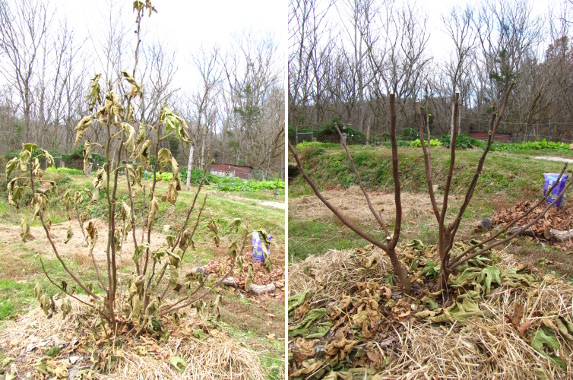
As Mark
mentioned last night,
our larger fig was ready to be swaddled just like his
younger sister.
The idea is that figs aren't really winter hardy here in zone 6, but
with some careful variety
selection and a
little love, you can
see get lots of fruits without babying a house plant.
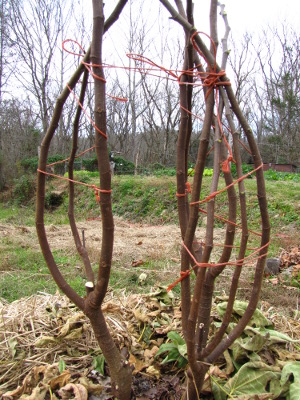 I'd
read that Chicago Hardy figs do best if cut back drastically to three
main trunks each winter, but when I pulled out the clippers, I suddenly
couldn't decide if that meant three main trunks with all of their side
branches or just three sticks coming out of the ground. So I went
for a moderate approach where I removed any tiny branches and ones that
would be shaded, but left multiple branches on each trunk.
I'd
read that Chicago Hardy figs do best if cut back drastically to three
main trunks each winter, but when I pulled out the clippers, I suddenly
couldn't decide if that meant three main trunks with all of their side
branches or just three sticks coming out of the ground. So I went
for a moderate approach where I removed any tiny branches and ones that
would be shaded, but left multiple branches on each trunk.
Next, I cut the tree
down to about three feet high. Some people keep their figs tall
and wrap the whole thing up, but it was awfully nice having fruits I
could pick without a ladder, and I can protect what's left better if I
shorten this year's growth. By carefully bending and then tying
the branches together, they formed a compact bundle, giving me plenty
of room to stuff leaves around them within an enclosure I made out of
lightweight fence posts and trellis material.
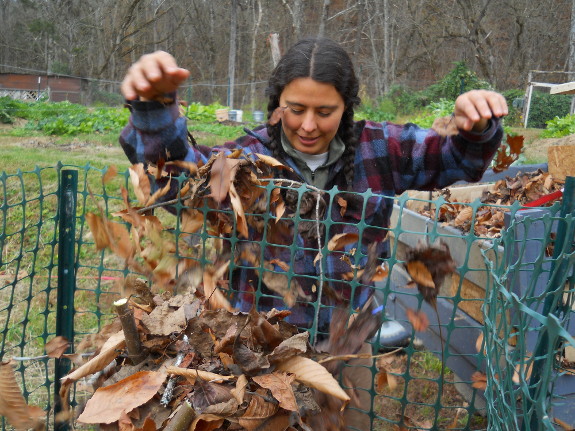
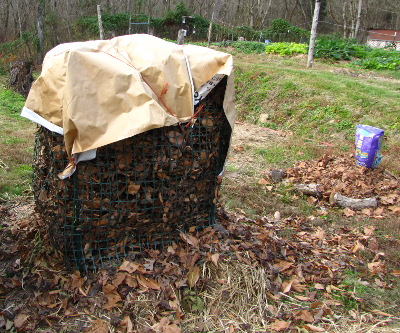 I topped it all off with a
cheap tarp that came on our roofing
tin. I felt
like last year's
frost protection
lost some efficiency when rain pounded down the insulating leaves and
exposed the tips of the fig branches. Hopefully this year's tarp
will prevent moisture entering my fig enclosure from above.
I topped it all off with a
cheap tarp that came on our roofing
tin. I felt
like last year's
frost protection
lost some efficiency when rain pounded down the insulating leaves and
exposed the tips of the fig branches. Hopefully this year's tarp
will prevent moisture entering my fig enclosure from above.
I saved nearly all of
the small branches to try rooting next year, and three of them already
had little roots forming (since I cut those 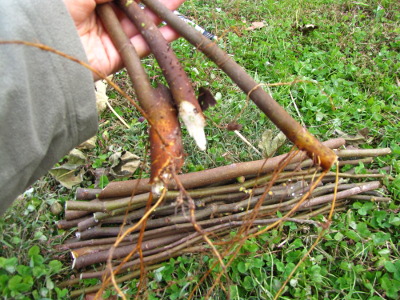 branches
off below the mulch line). Usually you gather
scionwood in the late winter, but it was necessary to chop our fig
down before wrapping it, so now I'm stuck trying to decide how to store
these cuttings in a cool, damp, but not freezing spot all winter.
We're really going to have to try to excavate our fridge root cellar
soon....
branches
off below the mulch line). Usually you gather
scionwood in the late winter, but it was necessary to chop our fig
down before wrapping it, so now I'm stuck trying to decide how to store
these cuttings in a cool, damp, but not freezing spot all winter.
We're really going to have to try to excavate our fridge root cellar
soon....
Want more in-depth information? Browse through our books.
Or explore more posts by date or by subject.
About us: Anna Hess and Mark Hamilton spent over a decade living self-sufficiently in the mountains of Virginia before moving north to start over from scratch in the foothills of Ohio. They've experimented with permaculture, no-till gardening, trailersteading, home-based microbusinesses and much more, writing about their adventures in both blogs and books.
Want to be notified when new comments are posted on this page? Click on the RSS button after you add a comment to subscribe to the comment feed, or simply check the box beside "email replies to me" while writing your comment.

My father used to dig a trench (shallow) and burry the fig tree over the winter. In the spring when the ground was workable he would unearth the tree and wait to harvest the fruit later on in the year. Living in southern Ontario surrounded by lots of italians it was not uncommon to see the trees protected by an enclosed green house attached to the house. In the winter the sun would heat the brick and gradually cool at night and during the day would get all warm and cozy all over again. Also the escaping heat of the house would prevent freezing (sometimes a small,fist sized, hole could be seen cut through the house exterior to protect the precious tree at night).